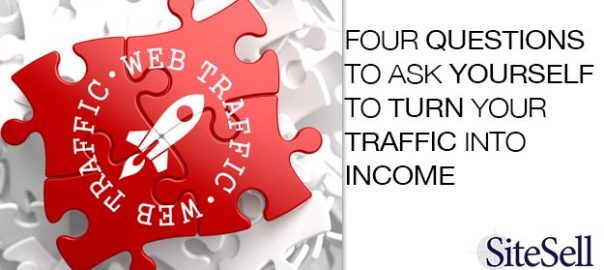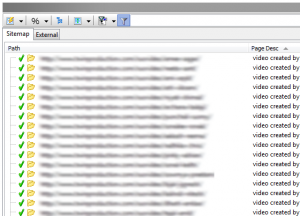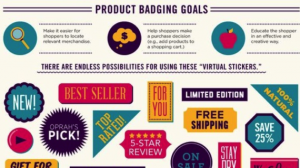
Congratulations! You just checked Google Analytics and you broke the 1,000 monthly visitors barrier.
Hooray!
. . . Now what?
What are you going to do with those 2,000 eyeballs (give or take a few) that saw your site?
I hate to tell you this, but the time to ask yourself that question was weeks or months ago, even before your mother started visiting your site, even before 10 visits a day was a milestone for you.
If you’ve gotten to this point without a plan, though, it’s not too late. You just need to spend a little time getting back to basics. Here are four questions to ask yourself.
#1. How Strong is My Niche?
Following your bliss is a great idea, but as a solopreneur, you also want some income. Ideally, the sweet spot occurs where your passion intersects with a large enough group of people looking for help in that area.
That’s your niche.
Your niche needs to be narrow enough to be manageable with the resources you have available (generally, time and money) and deep enough to attract some raving fans.
I’m not throwing out numbers here, because every industry is different, and only you know what resources you have to invest in developing your online business. If you’re building your business in your spare time while working a full-time job, realistically you need a narrower niche than I do if I’m putting in a full-time effort.
The good news is, both can work, and work well.
#2. How Well Do I Understand My Audience?
When you choose a niche based on your own passions and interests, you start with a big advantage — you already know a lot about the audience.
It’s vital to know your audience well. Even if you’re a member of that audience yourself, take some time to study it.
Familiarize yourself with a typical audience member’s:
- Likes
- Dislikes
- Fears
- Motivations
- Language (the words and phrases she uses when talking about the topic)
You should understand what keeps your audience awake at night, and what propels them to take action. You’ll find more insights into why it’s important to understand your audience here.
#3. Do I Already Have a Plan for Making Money?
If you have, you’re way ahead of the pack. Lots of people start websites, especially blogs, without any definite plans for doing business on those sites.
While that results in a lot of wasted time and lost revenue, you can still turn an aimless hobby into a profitable online business. You’ve heard the expression, “The best time to plant a tree is 20 years ago. The next best time is today.”
The same is true with your website.
There are lots more ways to monetize a site today than were practical even three or four years ago.
At its most basic, there are only four ways to make money from a website:
- Providing a service
- Selling your own product
- Selling someone else’s product
- Advertising
Within each of these categories, though, are dozens, even hundreds, of possibilities.
Providing a service
If you can provide a service, you already know what it is, based on your background and experience.
Some broad service categories include:
- Teaching
- Consulting
- Programming
- Designing
- Being a virtual assistant
- Investigating
- Researching
- Accounting
Selling your own products
These can be physical products, like handicrafts, art, photography, woodworking, or books. Or they can be digital products, including:
- Ebooks
- Courses
- Photographs
- Digital art
- Video
- Music
- Graphic design
I heard recently about a solopreneur earning a hefty six-figure income teaching people how to do hand lettering — talk about a niche!
Selling other people’s products
Again, these can be physical or digital products.
For digital products, use affiliate links to tell your readers about a particular product (or service). When your reader clicks and buys, you earn a commission.
Some of these require a high volume of traffic (selling Amazon.com books, for example).
If you’re going to use affiliate links, be prepared to offer your readers something that adds to the value of that product.
For example, if I want to promote a certain WordPress theme on my site, I’ll take the time to install it on a test site, take screenshots, and write a thoughtful review. This serves a dual purpose — I’m adding new content that has value to my readers, and I earn money when readers buy.
It’s now easier than ever to sell other people’s physical products, too. Resources like Alibaba.com make it simple to find, offer, and fill orders for all sorts of products.
Advertising
The days when you could throw a few AdSense ads onto your site and watch the money flow in are pretty much gone. To earn money today with AdSense or a similar aggregator service, you need to have huge traffic.
Instead, look for companies in your niche that are willing to pay you directly for an advertising slot on your site.
Here are 3 articles to give you more information about money-making strategies:
#4. Do I Have an Email List?
If you don’t, you’re missing out. Not only is email not dead, but prominent solopreneurs like Chris Brogan credit email for the majority of their revenue.
Set up an account with an email provider like Aweber or Mailchimp. (If you subscribe to SBI!, email is built into the service, and Mailchimp integration is coming.) The service will store your list, and will send the email.
(Note that we’re not talking here about the occasional email you send to a specific reader, customer or client. This is for bulk email.)
If you use WordPress, you may be thinking, “but why should I pay for this service when I can get a free plugin to do the same thing?”
The answer is simple — when you spend the time to craft a valuable email for your list, you want that message to make it all the way to your readers’ inboxes. If you send from WordPress, your delivery rate plummets.
Figure out what you can offer your readers in exchange for their email address. Ebooks in PDF format are still popular gifts in exchange for email, but don’t limit yourself. Other possibilities include:
- Short email autoresponder courses
- Video content
- Audio content
- Webinars
Whatever your giveaway, it should be valuable enough that readers are willing to “buy” it for the price of their email address.
It’s a good idea to tell readers clearly, up front, what they can expect. Will you email every day? Every week? Twice a month? “Occasionally?” Let them know.
Plan your email strategy to provide useful free content, with an occasional pitch. If every email is selling something, readers will quickly unsubscribe. Limit your sales calls to one out of every three or four emails, at least initially.
Make a Plan and Implement It
Once you have all the pieces figured out, you’re ready to put together your monetization plan. Now you can steer that site traffic in profitable ways!
If you’re an SBI! or SBI! for WP member, review DAYs 4 and 10 of the Action Guide for more help with monetization strategies.
Put together a basic sales funnel, then study your website with an eye to moving readers into that funnel.
Look at each page. What’s the most desired action you want a reader to take? Maybe it’s signing up for your email list, or maybe it’s sharing a piece of content on social media. Perhaps it’s hiring you to provide a service, or making a purchase.
Get into the habit of asking readers to do something, even if it’s something very small like sharing a link. When it’s time to sell something, they’ll be more willing to buy.
Once you’ve implemented your monetization plan, it won’t be just Google Analytics telling you your traffic has increased. You’ll see it in your bottom line.
Digital & Social Articles on Business 2 Community(46)
Report Post







